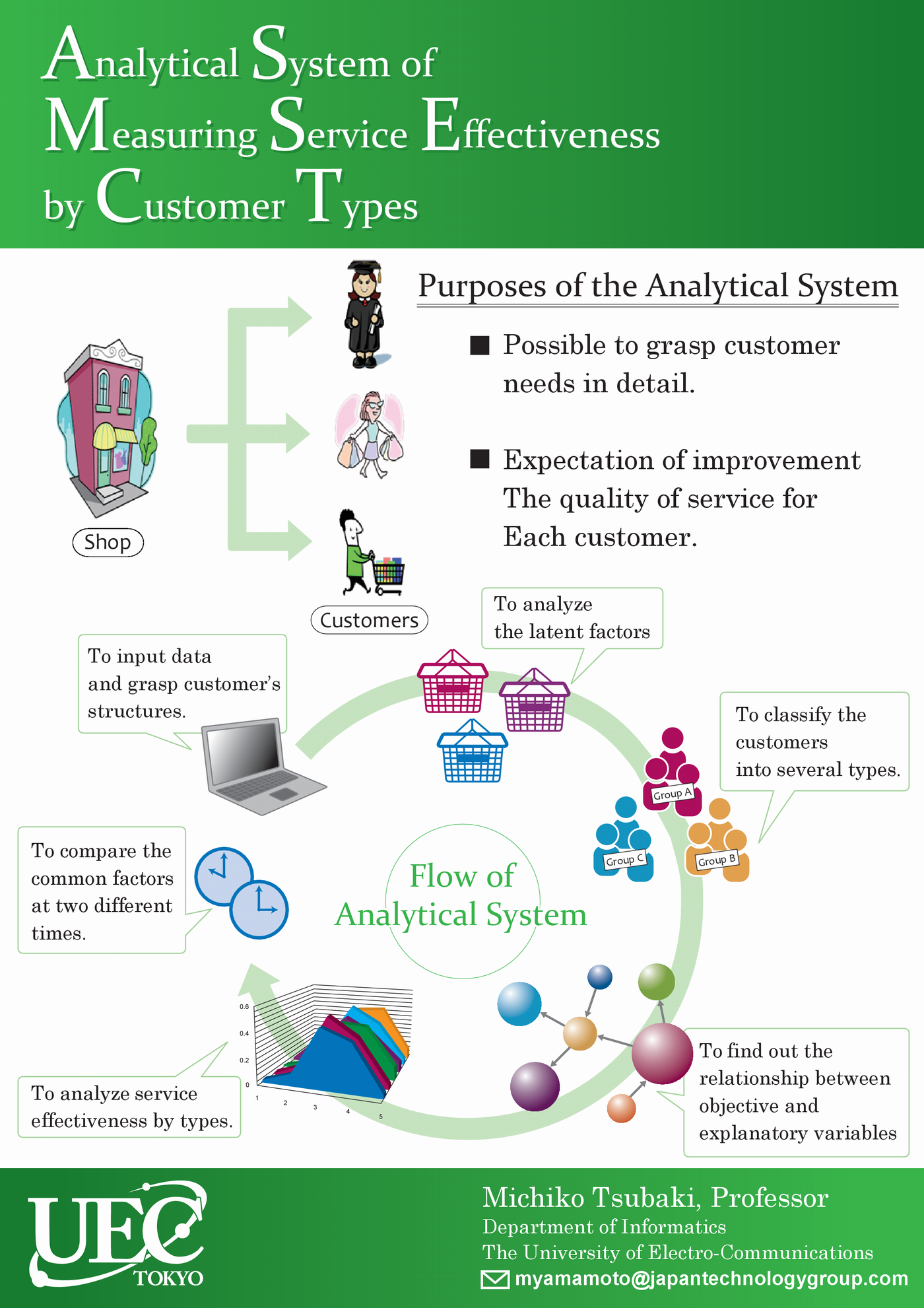June 2016 Issue
Feature
Advanced analytical service science based on big data
Integrating big data and statistical mathematics for an individual-priority-based approach to analyze and devise methods for improving the quality of business services and education environments.
Michiko Tsubaki is the UEC-vice-president responsible for public relations and an expert in statistical mathematics conducting research on innovative analytical approaches for improving the quality of service industries and education. "At junior high school I enjoyed both mathematics and Japanese literature," says Professor Tsubaki. "Inspiring teachers enabled me to excel in both subjects. I particularly enjoyed reading books by novelist Sōseki Natsume, whose classics include I am a Cat and Botchan. Later, having finished reading all of the works of Sōseki Natsume, I knew that he had the opportunity to read the book "the grammar of science" which was written by English statistician, Prof. Karl Pearson, in London. Sōseki ' s works on novels and "the theory of literature" affected by Karl Pearson, really left an impression on me. This experience was a major turning point in my life, and eventually led to my decision to go into the sciences, and applied mathematics."
Professor Tsubaki is currently pursuing research into the improvement of the quality and co-creation of new values in service industries, as well as the education environment and learning capabilities of young people. This research reflects the fact that the service sector accounts for 70% of Japan's GDP. Notably, Professor Tsubaki's research is based on the application of her unique analytical system for measuring the effectiveness of a specific service based on individual customer types. "Our analytical system enables us to ascertain the individual needs of a wide range of customers," explains Professor Tsubaki. "The strength of our analysis lies in its ability to match the heterogeneous needs of both customers and service providers. We provide industrial partners with quantitative analysis on methods to improve customer satisfaction and the quality of services for individual customers with specific demands."
In the case of customers shopping in a supermarket, the analytical system classifies customers into several types; determines the relationship between the objective and explanatory variables; analyzes the effectiveness of service by type; and compares the common factors at two different times.

Research highlights
Emotion hierarchy diagram (EHD) for designing specific order-made service processes
Research shows that customers who receive high quality service at coffee shops are more likely to become regular customers--so called repeaters. Satisfied customers will spread the word of their experience--good or bad--by word of mouth. So needless to say, it is imperative for the success of such businesses to analysis customer preferences and design processes to provide highly valuable services.
Here, Professor Tsubaki and colleagues decompose and analyze abstract emotions such as 'excitement' to design specific, customer orientated high quality service processes. Examples of emotions and elements of excitement in a café include: excitement of studying/café where customers can work without being disturbed; excitement of using new things/ café where robots serve customers; and excitement of experiencing the extraordinary/ café with Indian décor and movies.
Big Data based analysis of relationships between customers and service providers
It's intuitive to think that customer satisfaction is an important factor affecting the sales of businesses. In order to analyze this premise, Professor Tsubaki is using 'big data' from a major Japanese company that specializes in providing carpet and other such cleaning services to determine whether company sales could be improved by assigning one company rep to one customer--that is, matching the needs of customers and service providers. Another goal of the research is to clarify the link between job satisfaction amongst company employees and company sales. Initial results based on data from one of the many branches of the cleaning company show that both one-to-one customer-sales rep relationships and employee satisfaction do indeed lead to improvements in the sales of the company.
Education and learning
The analytical system is also being applied for improving education and teaching. In one project, Professor Tsubaki is looking into simultaneity and heterogeneity, with the assumption that teaching and learning occur simultaneously and that students are from diverse and wide ranging backgrounds. Initial findings show that the 'learning style' is an important factor for the improvement of learning ability. Now, we study the classification of Students into types based on the critical thinking skills, and Modeling for improvement of English abilities of elementary school students based on the analysis of log data of learning process.
References
- Tokida,M. and Tsubaki, M.(2016): "Classification of Students into Types Based on the Critical Thinking Skills and Analysis of the Effectiveness of Education and Learning Experience to the Critical Thinking Skills by Type," Japanese Journal of Educational Technology, Vo.39,No.4, 259-270.
- Tsubaki,M., Gonda,S., Kato,N. and Maeda,Y.(2015): "A Study on Modeling and Verification for Improvement of English Abilities of Elementary School Students Based on the Analysis of Log Data of Learning Process using the Sound Pen," Japanese Journal of Educational Information, Vo.31,No.1, 43-54.
- Haraga,S., Tsubaki, M.and Suzuki,T. (2014): "Expansion of the Analytical System of Measuring Service Effectiveness by Customer Type to Include Repeat Analysis," International Journal of Social and Humanity, Vol.4, No.2,194-200.
- Kurosumi,S. and Tsubaki,M.(2014): "A Study on Interactive Educational and Learning Communication in Consideration of Simultaneity and Heterogeneity for Improving the Quality of Education," International Journal of Social Science and Humanity,Vol.4, No. 2, 132-137.
- Tsubaki,M., Oya,T. and Kobayashi,T.(2012):"Analysis for the Design of Effective Learning Activities Using Learning-Type PDCA and CAPD Cycles on the Basis of Characteristics of Individual Students," International Journal of Knowledge and Learning, Vol.8, No.1-2,150-165.



